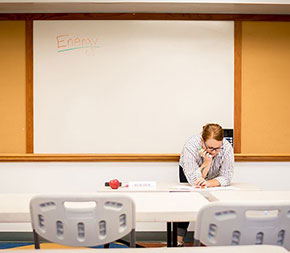Teaching Math Online: An In-Depth Teacher Interview

by All Star Staff


Mel Taylor
Online Math Professor
Ridgewater College, Willmar, Minnesota
Mel Taylor wanted to teach ever since she was in the 3rd grade. She has now been teaching math for over 38 years, and has specialized in teaching online math courses for eight years. For the last three years, she has been teaching online classes exclusively. We caught up with Mel not at her Minnesota school but-as you might expect-online.
Q: Tell us about your experience teaching online.
A: I began teaching Online Mathematics for Elementary Teachers so that students could complete their B.S. or B.A. degree in Elementary Education through an online program called DLiTE through Bemidji State University.
I am not very tech-savvy. I graduated from college when the slide rule was our calculator. I have become increasingly comfortable with online technology the more I teach online.
Q: How do online math classes work?
A: The advantages of online teaching are many. Students can be anywhere in the world and take my online courses. They can work on their assignments at any time of day or night and submit them at any point before the due date. I can also tutor them any day of the week and at any time. I use the chat room for this interaction and it may take anywhere from 15 minutes to three hours.
Another advantage of teaching online math is that students from other campuses throughout the world can access a course that may not be offered at their campus. Military personnel also find online classes of great help as they can continue their course work while stationed overseas.
The LMS platform that we use at Minnesota State and Community Colleges is called D2L (Desire to Learn). I use Dropbox, discussion boards, chat rooms and Skype. In addition, I do my own audio PowerPoint presentations for various math concepts that students can access on their own time. I assign weekly assignments, which students complete in Word documents and submit to me in Dropbox. They can also be hand-written and scanned or faxed. Tests are taken at test centers on our two campuses or are administered by a proctor at other locations.
Q: How can students maximize the online experience?
A: Students first need to realize that taking a course online usually demands more time and effort than an on-campus class.
Keeping this in mind, they should make sure to set aside enough time each week for the course assignments and tests. It is helpful if they set up a regular time of day to work on their assignments, just like they would in a regular class. Online students who have problems might let their course work slide and then try to catch up in a hurry. This never works, especially in mathematics.
It is also helpful for students to help each other and I encourage them to ask as soon as they have a question so they don’t get bogged down. This is also why I have chat groups, so that students are forced to interact and help one other.
Q: What are some concerns of students coming to online education for the first time?
A: I was worried when I first started teaching online that it might be too impersonal, as I love to interact with students. I really have found the opposite to be true. I have become closer to some students than I might have on campus because I spend so much time with them online. I have also found that shy students will open up more online than they would have in person.

Students coming online for the first time might be nervous about navigating through a course, especially math, because many are very fearful of mathematics anyhow. That is why I suggest that students get into a course early and try out the technology before class begins.
I know what it was like when I started teaching online and didn’t know what to do. There were times I could have thrown the computer out the window…and almost did! I don’t want my students to feel that way.
Q: What would you recommend for online teachers?
A: Teachers need to realize that teaching online takes more time and effort than teaching on campus. Therefore, they need to give themselves plenty of time to prepare their courses. Here is some advice for online teachers that I’ve found helpful:
- Start setting up each course six to 12 months ahead of time.
- Send a welcome letter and syllabus to your students two to three weeks before class starts.
- Make sure all assignments are clear, and that students know where to submit their assignments, chats, etc.
- Don’t add any new assignments once the class has started.
- Check your webpage and email regularly, and always respond to students in a timely manner


